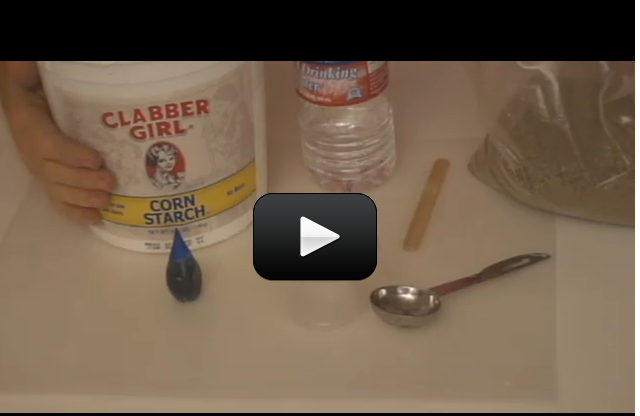A non-Newtonian fluid is a substance that changes viscosity, such as ketchup. Ever notice how ketchup sticks to the bottom of the bottle one minute and comes sliding out the next?
Think of viscosity as the resistance stuff has to being smeared around. Water is “thin” (low viscosity); honey is “thick” (high viscosity). You are about to make a substance that is both (low and high viscosity), depending on what ratio you mix up. Feel free to mix up a larger batch then indicated in the video – we’ve heard from families that have mixed up an entire kiddie pool of this stuff!
[am4show have=’p8;p9;p11;p38;p92;p13;p40;p68;’ guest_error=’Guest error message’ user_error=’User error message’ ]
- cornstarch (about 2 cups)
- water (about 1 cup)
- sand (about 2 cups)
Your first step is to create a 2:1 ratio of cornstarch to water (2 cups cornstarch to 1 cup water). (This is your non-Newtonian fluid.) Grab it with your fist and it will turn rock-solid and crumble; open your hand and it will flow right between your fingers. It’s both a solid and a liquid (it changes viscosity depending on its environment, which is your hand right now). By adding sand to this concoction, you can make moon sand.
Download Student Worksheet & Exercises
Moon sand is basically clay with a beach twist. If you’ve ever tried making a sand castle, you know the disappointment of having the structure crumble after hours of work. Moon sand adds the best properties of clay to the sand for a moldable, sandy texture that’s easy to work with — and it’s dirt cheap to mix up your weight in moon sand.
Your task is to find the perfect ratio of the three ingredients to make this weird substance. If you have too much water, you’ll get a substance that is both a liquid and a solid (as you did before with the non-Newtonian fluid). Too much solid, and it crumbles.
Troubleshooting: The smaller the grain of sand you have, the easier it is to form intricate shapes. If you find white sand, it’ll make better colors when you add food dye to the mixture. Use a large enough bowl and try to keep one hand clean so you can add more (of whatever you need) as you go along. The ideal mixture is approximately 2 cups sand, 2 cups cornstarch, and 1 cup water, give or take a bit. Notice how adding just a small amount of water turns it into a liquid, and adding a tiny bit more cornstarch (or sand) makes it crumble as if it were solid? Take your time to get this mixture just right. (We’ve filled up an entire plastic kiddie pool with this stuff!)
[/am4show]


Any kind of sand will work, but the smaller the grains, the easier it will be to make shapes.
Hi! Can this be beach sand (salty) or better river (or playground) sand? Thank you
Actual Kinetic sand is coated with silicon, which isn’t something you can do at home. But the instructions on this page show you how to make something similar.
what is kinetic sand made out of, and can I make my own??
No, not unless you put in food dye!
dos it color my hands?